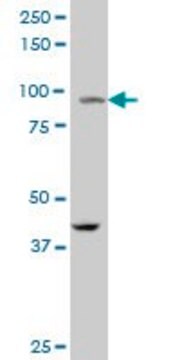About This Item
Polecane produkty
pochodzenie biologiczne
rat
Poziom jakości
białko sprzężone
unconjugated
forma przeciwciała
purified antibody
rodzaj przeciwciała
primary antibodies
klon
2B8 (#8), monoclonal
masa cząsteczkowa
calculated mol wt 225.65 kDa
observed mol wt ~225 kDa
reaktywność gatunkowa
mouse
reaktywność gatunkowa (przewidywana na podstawie homologii)
human
opakowanie
antibody small pack of 100 μL
metody
immunofluorescence: suitable
immunoprecipitation (IP): suitable
western blot: suitable
izotyp
IgG2aκ
numer dostępu UniProt
Warunki transportu
dry ice
temp. przechowywania
2-8°C
docelowa modyfikacja potranslacyjna
unmodified
Opis ogólny
Specyficzność
Immunogen
Zastosowanie
Evaluated by Western Blotting in lysate from wild-type Mouse neuronal stem cells.
Western Blotting Analysis (WB): A 1:500 dilution of this antibody detected Structural maintenance of chromosomes flexible hinge domain-containing protein 1 (SMCHD1) in lysate from wild-type Mouse neuronal stem cells, but not in Smchd1 null cells.
Tested Applications
Western Blotting Analysis: A representative lot detected SMCHD1 in Western Blotting applications (Jansz, N., et. al. (2018). Cell Rep. 25(7):1912-1923).
Immunofluorescence Analysis: A representative lot detected SMCHD1 in Immunofluorescence applications (Jansz, N., et. al. (2018). Cell Rep. 25(7):1912-1923).
Immunoprecipitation Analysis: A representative lot immunoprecipitated SMCHD1 in Immunoprecipitation applications (Jansz, N., et. al. (2018). Cell Rep. 25(7):1912-1923).
Note: Actual optimal working dilutions must be determined by end user as specimens, and experimental conditions may vary with the end user
Postać fizyczna
Przechowywanie i stabilność
Inne uwagi
Oświadczenie o zrzeczeniu się odpowiedzialności
Nie możesz znaleźć właściwego produktu?
Wypróbuj nasz Narzędzie selektora produktów.
Kod klasy składowania
12 - Non Combustible Liquids
Klasa zagrożenia wodnego (WGK)
WGK 1
Temperatura zapłonu (°F)
Not applicable
Temperatura zapłonu (°C)
Not applicable
Certyfikaty analizy (CoA)
Poszukaj Certyfikaty analizy (CoA), wpisując numer partii/serii produktów. Numery serii i partii można znaleźć na etykiecie produktu po słowach „seria” lub „partia”.
Masz już ten produkt?
Dokumenty związane z niedawno zakupionymi produktami zostały zamieszczone w Bibliotece dokumentów.
Nasz zespół naukowców ma doświadczenie we wszystkich obszarach badań, w tym w naukach przyrodniczych, materiałoznawstwie, syntezie chemicznej, chromatografii, analityce i wielu innych dziedzinach.
Skontaktuj się z zespołem ds. pomocy technicznej